Clariton Antiques: Financial Resource Management and Decisions Report
VerifiedAdded on 2020/01/23
|20
|5515
|50
Report
AI Summary
This report provides a comprehensive analysis of financial resource management and decision-making, focusing on Clariton Antiques. It begins by identifying and differentiating between internal and external sources of finance, discussing their implications, and evaluating their suitability for the business. The report then delves into the cost of capital for various financing sources, including dividends and interest, and emphasizes the importance of financial planning, covering budgeting and the implications of poor financial planning. Furthermore, it examines the information required for making financing decisions from the perspectives of partners, venture capitalists, and finance brokers, while also exploring their influence on financial statements. The report also includes computations for budgeted collections and payments, unit cost analysis for pricing decisions, and capital expenditure decisions. Finally, it discusses the elements of financial statements and compares the format used by Clariton Antiques to that of a sole trader, followed by an analysis of key accounting ratios.
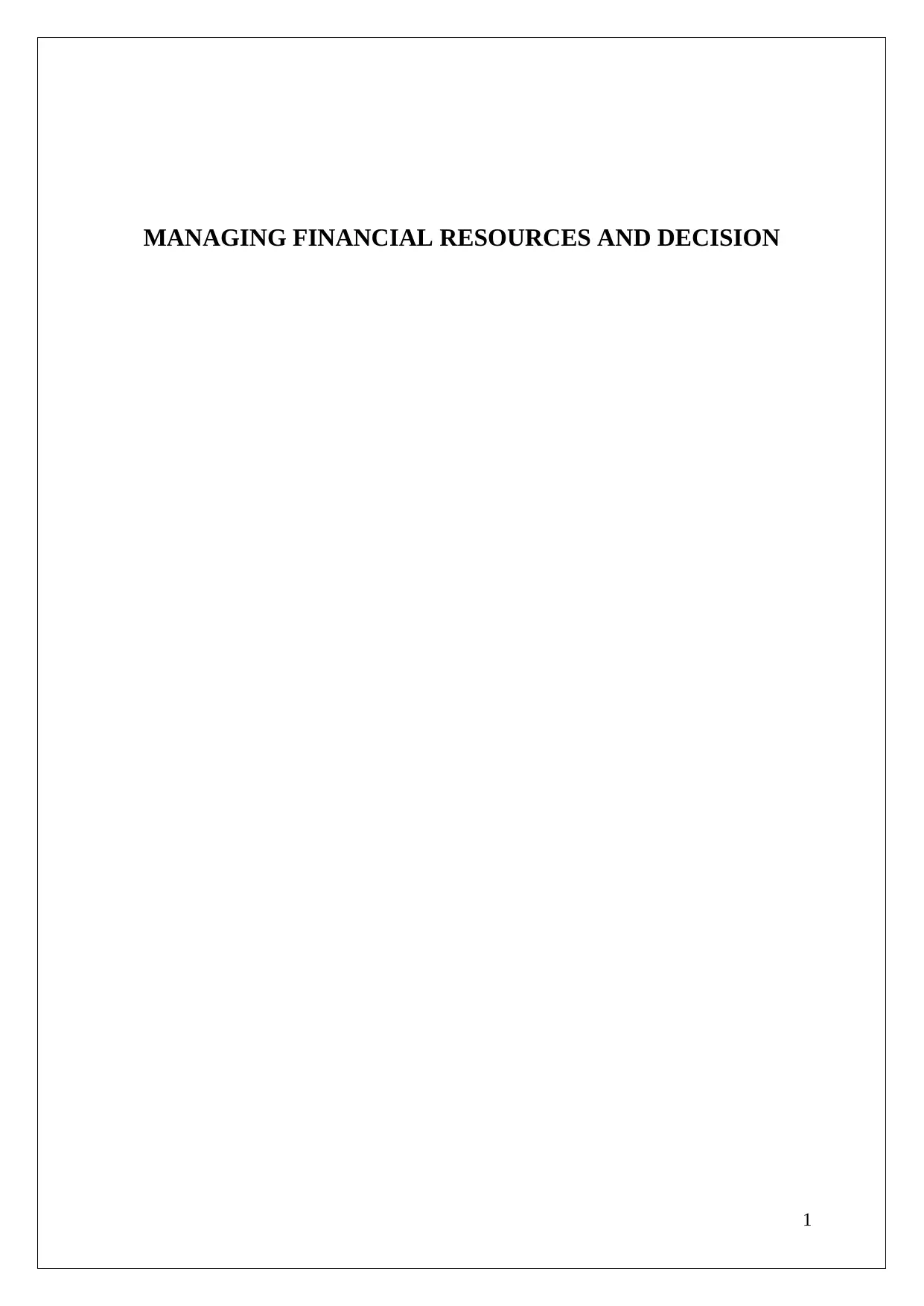
MANAGING FINANCIAL RESOURCES AND DECISION
1
1
Paraphrase This Document
Need a fresh take? Get an instant paraphrase of this document with our AI Paraphraser
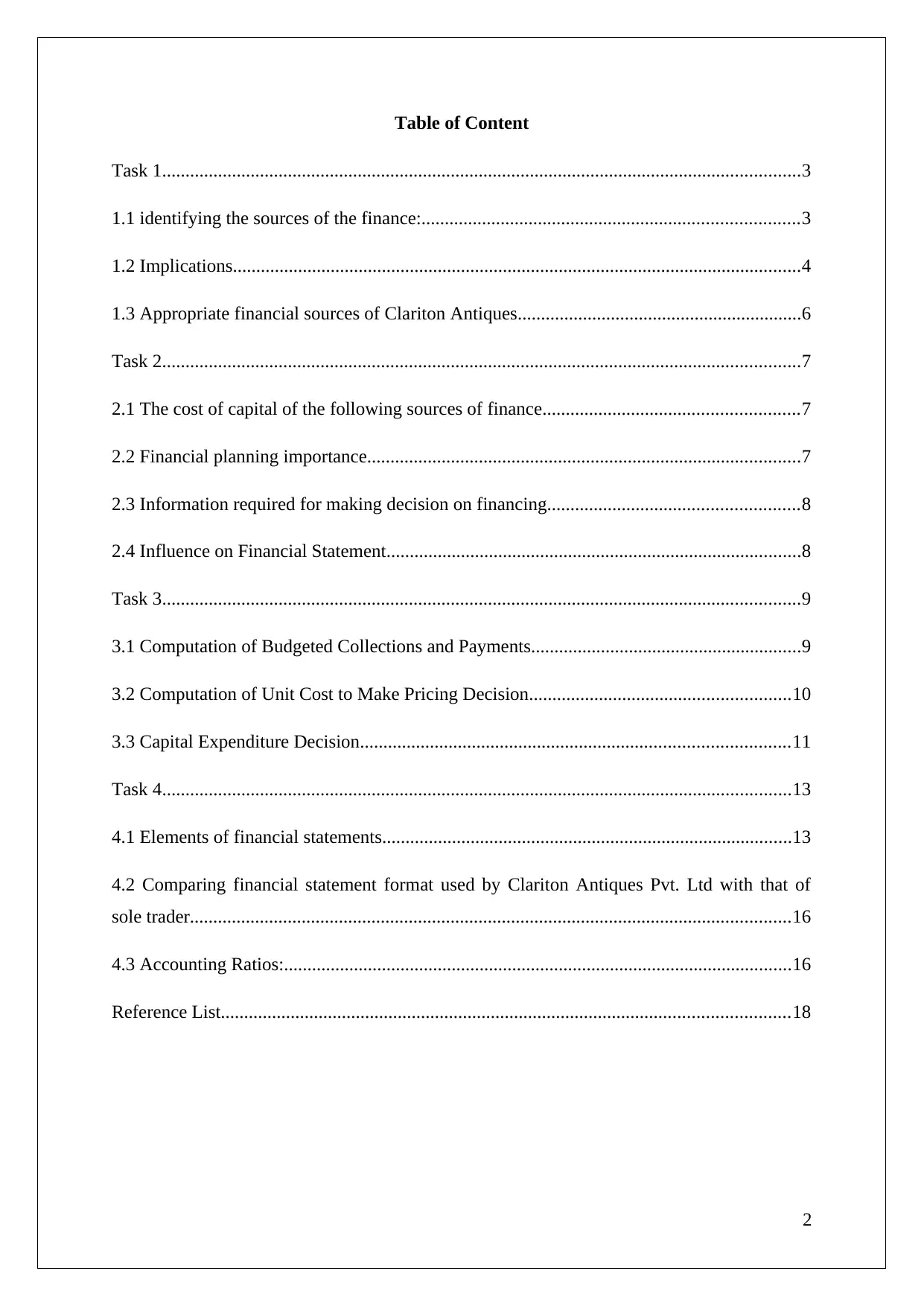
Table of Content
Task 1.........................................................................................................................................3
1.1 identifying the sources of the finance:.................................................................................3
1.2 Implications..........................................................................................................................4
1.3 Appropriate financial sources of Clariton Antiques.............................................................6
Task 2.........................................................................................................................................7
2.1 The cost of capital of the following sources of finance.......................................................7
2.2 Financial planning importance.............................................................................................7
2.3 Information required for making decision on financing......................................................8
2.4 Influence on Financial Statement.........................................................................................8
Task 3.........................................................................................................................................9
3.1 Computation of Budgeted Collections and Payments..........................................................9
3.2 Computation of Unit Cost to Make Pricing Decision........................................................10
3.3 Capital Expenditure Decision............................................................................................11
Task 4.......................................................................................................................................13
4.1 Elements of financial statements........................................................................................13
4.2 Comparing financial statement format used by Clariton Antiques Pvt. Ltd with that of
sole trader.................................................................................................................................16
4.3 Accounting Ratios:.............................................................................................................16
Reference List..........................................................................................................................18
2
Task 1.........................................................................................................................................3
1.1 identifying the sources of the finance:.................................................................................3
1.2 Implications..........................................................................................................................4
1.3 Appropriate financial sources of Clariton Antiques.............................................................6
Task 2.........................................................................................................................................7
2.1 The cost of capital of the following sources of finance.......................................................7
2.2 Financial planning importance.............................................................................................7
2.3 Information required for making decision on financing......................................................8
2.4 Influence on Financial Statement.........................................................................................8
Task 3.........................................................................................................................................9
3.1 Computation of Budgeted Collections and Payments..........................................................9
3.2 Computation of Unit Cost to Make Pricing Decision........................................................10
3.3 Capital Expenditure Decision............................................................................................11
Task 4.......................................................................................................................................13
4.1 Elements of financial statements........................................................................................13
4.2 Comparing financial statement format used by Clariton Antiques Pvt. Ltd with that of
sole trader.................................................................................................................................16
4.3 Accounting Ratios:.............................................................................................................16
Reference List..........................................................................................................................18
2
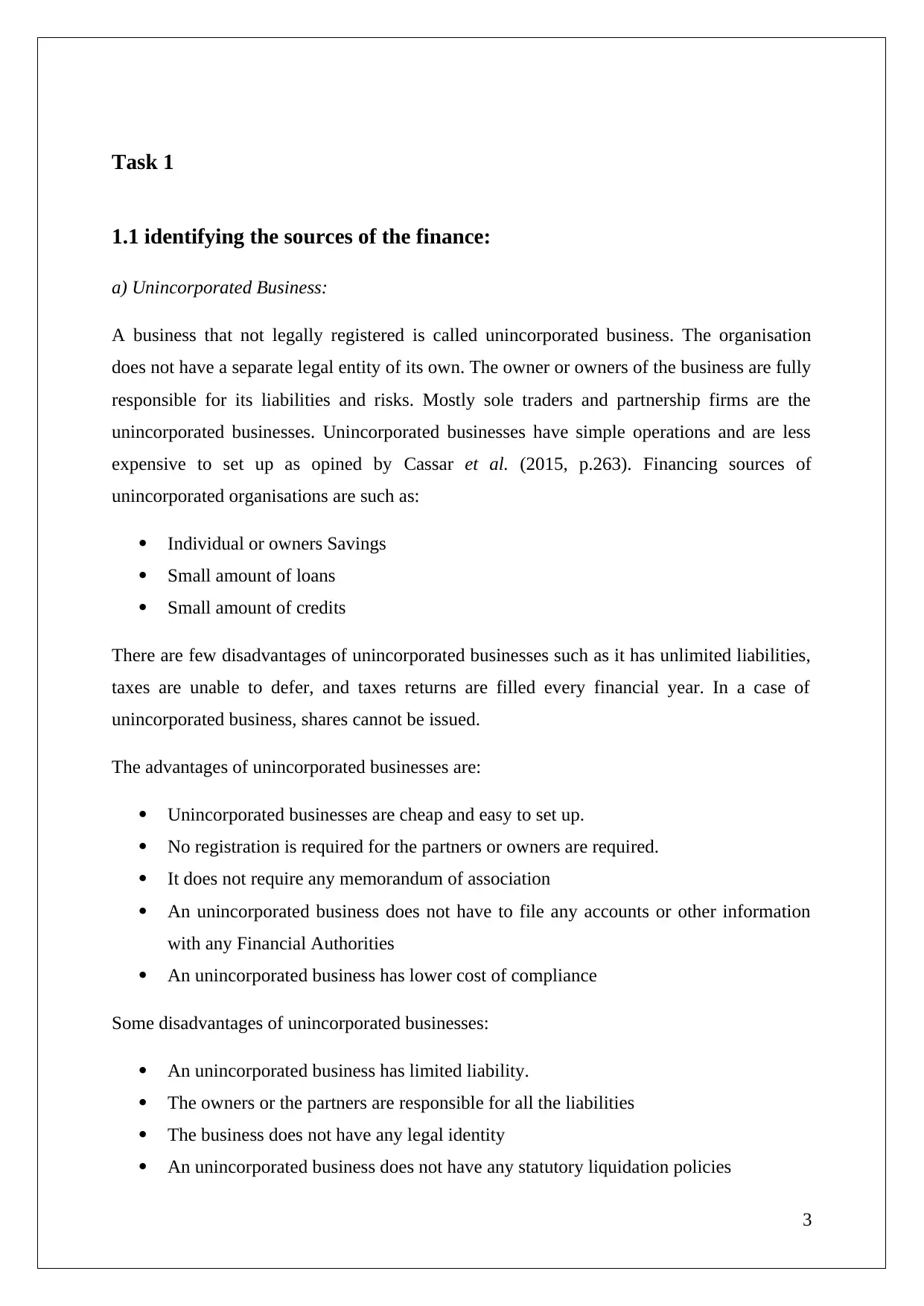
Task 1
1.1 identifying the sources of the finance:
a) Unincorporated Business:
A business that not legally registered is called unincorporated business. The organisation
does not have a separate legal entity of its own. The owner or owners of the business are fully
responsible for its liabilities and risks. Mostly sole traders and partnership firms are the
unincorporated businesses. Unincorporated businesses have simple operations and are less
expensive to set up as opined by Cassar et al. (2015, p.263). Financing sources of
unincorporated organisations are such as:
Individual or owners Savings
Small amount of loans
Small amount of credits
There are few disadvantages of unincorporated businesses such as it has unlimited liabilities,
taxes are unable to defer, and taxes returns are filled every financial year. In a case of
unincorporated business, shares cannot be issued.
The advantages of unincorporated businesses are:
Unincorporated businesses are cheap and easy to set up.
No registration is required for the partners or owners are required.
It does not require any memorandum of association
An unincorporated business does not have to file any accounts or other information
with any Financial Authorities
An unincorporated business has lower cost of compliance
Some disadvantages of unincorporated businesses:
An unincorporated business has limited liability.
The owners or the partners are responsible for all the liabilities
The business does not have any legal identity
An unincorporated business does not have any statutory liquidation policies
3
1.1 identifying the sources of the finance:
a) Unincorporated Business:
A business that not legally registered is called unincorporated business. The organisation
does not have a separate legal entity of its own. The owner or owners of the business are fully
responsible for its liabilities and risks. Mostly sole traders and partnership firms are the
unincorporated businesses. Unincorporated businesses have simple operations and are less
expensive to set up as opined by Cassar et al. (2015, p.263). Financing sources of
unincorporated organisations are such as:
Individual or owners Savings
Small amount of loans
Small amount of credits
There are few disadvantages of unincorporated businesses such as it has unlimited liabilities,
taxes are unable to defer, and taxes returns are filled every financial year. In a case of
unincorporated business, shares cannot be issued.
The advantages of unincorporated businesses are:
Unincorporated businesses are cheap and easy to set up.
No registration is required for the partners or owners are required.
It does not require any memorandum of association
An unincorporated business does not have to file any accounts or other information
with any Financial Authorities
An unincorporated business has lower cost of compliance
Some disadvantages of unincorporated businesses:
An unincorporated business has limited liability.
The owners or the partners are responsible for all the liabilities
The business does not have any legal identity
An unincorporated business does not have any statutory liquidation policies
3
⊘ This is a preview!⊘
Do you want full access?
Subscribe today to unlock all pages.

Trusted by 1+ million students worldwide
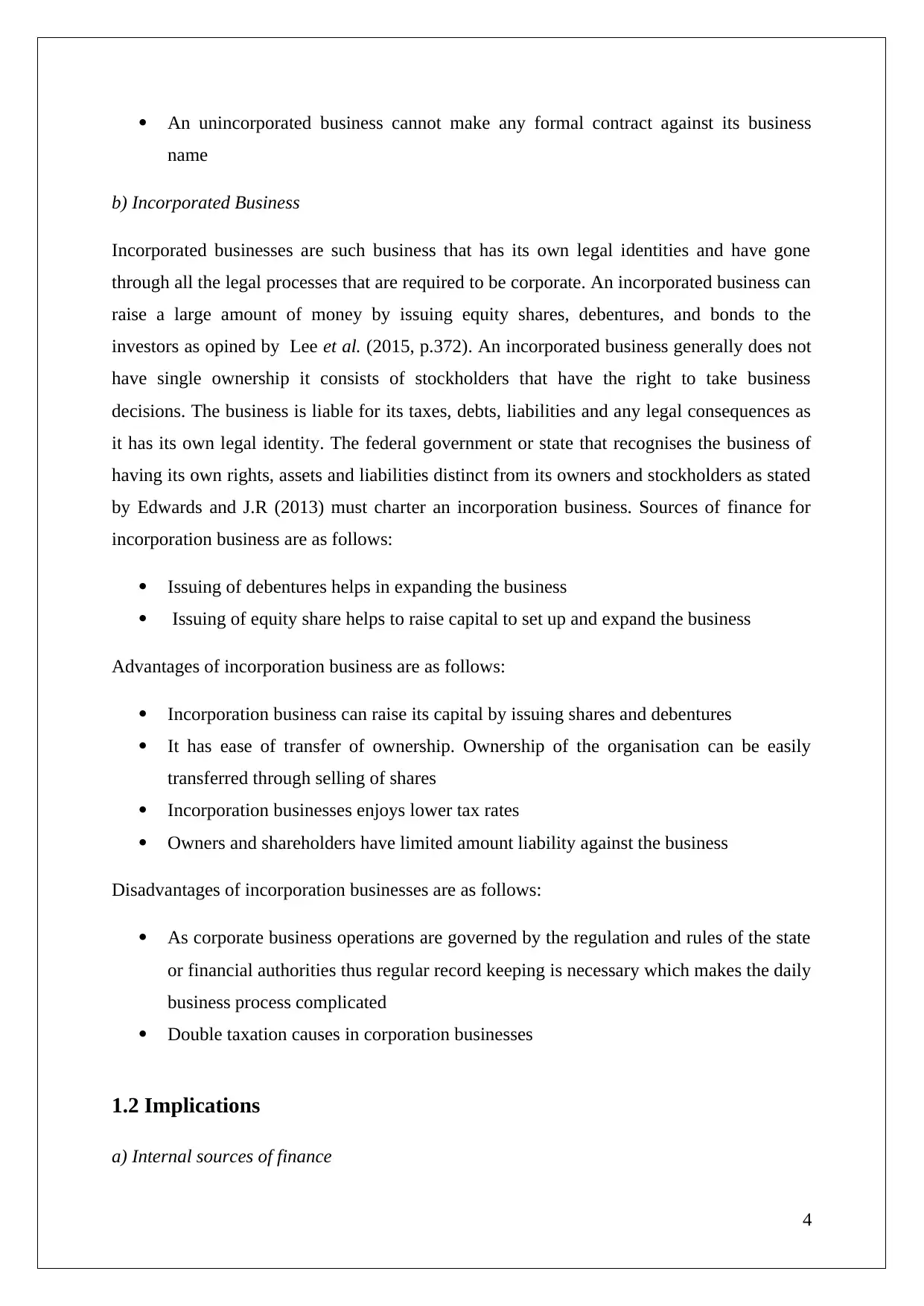
An unincorporated business cannot make any formal contract against its business
name
b) Incorporated Business
Incorporated businesses are such business that has its own legal identities and have gone
through all the legal processes that are required to be corporate. An incorporated business can
raise a large amount of money by issuing equity shares, debentures, and bonds to the
investors as opined by Lee et al. (2015, p.372). An incorporated business generally does not
have single ownership it consists of stockholders that have the right to take business
decisions. The business is liable for its taxes, debts, liabilities and any legal consequences as
it has its own legal identity. The federal government or state that recognises the business of
having its own rights, assets and liabilities distinct from its owners and stockholders as stated
by Edwards and J.R (2013) must charter an incorporation business. Sources of finance for
incorporation business are as follows:
Issuing of debentures helps in expanding the business
Issuing of equity share helps to raise capital to set up and expand the business
Advantages of incorporation business are as follows:
Incorporation business can raise its capital by issuing shares and debentures
It has ease of transfer of ownership. Ownership of the organisation can be easily
transferred through selling of shares
Incorporation businesses enjoys lower tax rates
Owners and shareholders have limited amount liability against the business
Disadvantages of incorporation businesses are as follows:
As corporate business operations are governed by the regulation and rules of the state
or financial authorities thus regular record keeping is necessary which makes the daily
business process complicated
Double taxation causes in corporation businesses
1.2 Implications
a) Internal sources of finance
4
name
b) Incorporated Business
Incorporated businesses are such business that has its own legal identities and have gone
through all the legal processes that are required to be corporate. An incorporated business can
raise a large amount of money by issuing equity shares, debentures, and bonds to the
investors as opined by Lee et al. (2015, p.372). An incorporated business generally does not
have single ownership it consists of stockholders that have the right to take business
decisions. The business is liable for its taxes, debts, liabilities and any legal consequences as
it has its own legal identity. The federal government or state that recognises the business of
having its own rights, assets and liabilities distinct from its owners and stockholders as stated
by Edwards and J.R (2013) must charter an incorporation business. Sources of finance for
incorporation business are as follows:
Issuing of debentures helps in expanding the business
Issuing of equity share helps to raise capital to set up and expand the business
Advantages of incorporation business are as follows:
Incorporation business can raise its capital by issuing shares and debentures
It has ease of transfer of ownership. Ownership of the organisation can be easily
transferred through selling of shares
Incorporation businesses enjoys lower tax rates
Owners and shareholders have limited amount liability against the business
Disadvantages of incorporation businesses are as follows:
As corporate business operations are governed by the regulation and rules of the state
or financial authorities thus regular record keeping is necessary which makes the daily
business process complicated
Double taxation causes in corporation businesses
1.2 Implications
a) Internal sources of finance
4
Paraphrase This Document
Need a fresh take? Get an instant paraphrase of this document with our AI Paraphraser
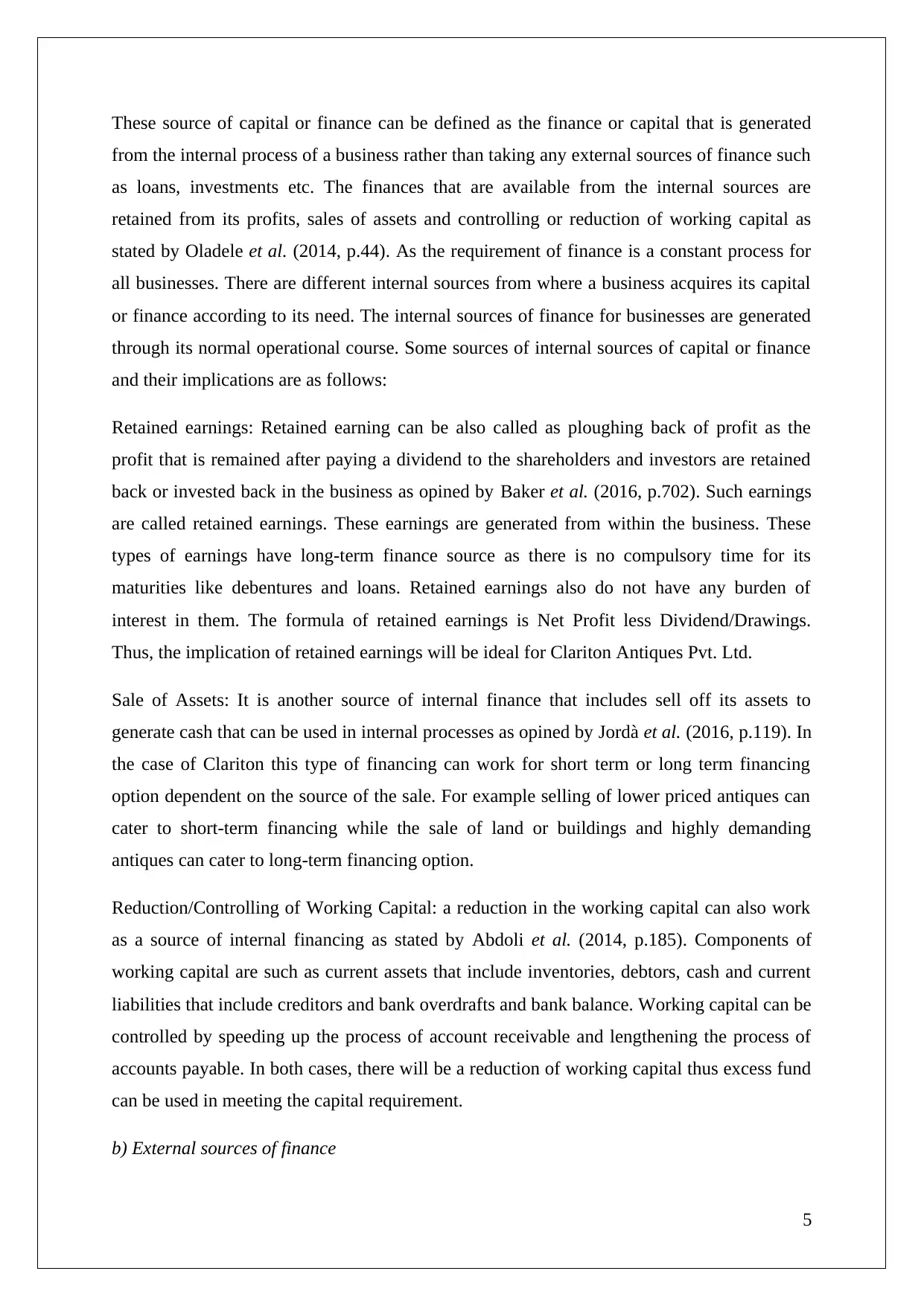
These source of capital or finance can be defined as the finance or capital that is generated
from the internal process of a business rather than taking any external sources of finance such
as loans, investments etc. The finances that are available from the internal sources are
retained from its profits, sales of assets and controlling or reduction of working capital as
stated by Oladele et al. (2014, p.44). As the requirement of finance is a constant process for
all businesses. There are different internal sources from where a business acquires its capital
or finance according to its need. The internal sources of finance for businesses are generated
through its normal operational course. Some sources of internal sources of capital or finance
and their implications are as follows:
Retained earnings: Retained earning can be also called as ploughing back of profit as the
profit that is remained after paying a dividend to the shareholders and investors are retained
back or invested back in the business as opined by Baker et al. (2016, p.702). Such earnings
are called retained earnings. These earnings are generated from within the business. These
types of earnings have long-term finance source as there is no compulsory time for its
maturities like debentures and loans. Retained earnings also do not have any burden of
interest in them. The formula of retained earnings is Net Profit less Dividend/Drawings.
Thus, the implication of retained earnings will be ideal for Clariton Antiques Pvt. Ltd.
Sale of Assets: It is another source of internal finance that includes sell off its assets to
generate cash that can be used in internal processes as opined by Jordà et al. (2016, p.119). In
the case of Clariton this type of financing can work for short term or long term financing
option dependent on the source of the sale. For example selling of lower priced antiques can
cater to short-term financing while the sale of land or buildings and highly demanding
antiques can cater to long-term financing option.
Reduction/Controlling of Working Capital: a reduction in the working capital can also work
as a source of internal financing as stated by Abdoli et al. (2014, p.185). Components of
working capital are such as current assets that include inventories, debtors, cash and current
liabilities that include creditors and bank overdrafts and bank balance. Working capital can be
controlled by speeding up the process of account receivable and lengthening the process of
accounts payable. In both cases, there will be a reduction of working capital thus excess fund
can be used in meeting the capital requirement.
b) External sources of finance
5
from the internal process of a business rather than taking any external sources of finance such
as loans, investments etc. The finances that are available from the internal sources are
retained from its profits, sales of assets and controlling or reduction of working capital as
stated by Oladele et al. (2014, p.44). As the requirement of finance is a constant process for
all businesses. There are different internal sources from where a business acquires its capital
or finance according to its need. The internal sources of finance for businesses are generated
through its normal operational course. Some sources of internal sources of capital or finance
and their implications are as follows:
Retained earnings: Retained earning can be also called as ploughing back of profit as the
profit that is remained after paying a dividend to the shareholders and investors are retained
back or invested back in the business as opined by Baker et al. (2016, p.702). Such earnings
are called retained earnings. These earnings are generated from within the business. These
types of earnings have long-term finance source as there is no compulsory time for its
maturities like debentures and loans. Retained earnings also do not have any burden of
interest in them. The formula of retained earnings is Net Profit less Dividend/Drawings.
Thus, the implication of retained earnings will be ideal for Clariton Antiques Pvt. Ltd.
Sale of Assets: It is another source of internal finance that includes sell off its assets to
generate cash that can be used in internal processes as opined by Jordà et al. (2016, p.119). In
the case of Clariton this type of financing can work for short term or long term financing
option dependent on the source of the sale. For example selling of lower priced antiques can
cater to short-term financing while the sale of land or buildings and highly demanding
antiques can cater to long-term financing option.
Reduction/Controlling of Working Capital: a reduction in the working capital can also work
as a source of internal financing as stated by Abdoli et al. (2014, p.185). Components of
working capital are such as current assets that include inventories, debtors, cash and current
liabilities that include creditors and bank overdrafts and bank balance. Working capital can be
controlled by speeding up the process of account receivable and lengthening the process of
accounts payable. In both cases, there will be a reduction of working capital thus excess fund
can be used in meeting the capital requirement.
b) External sources of finance
5

Finances or capitals that are acquired from external sources are referred to as an external
source of finance. Sources of external financing are share, preferred stock, debentures, long-
term loans, venture capital, hire purchase, bank overdraft etc. Issuing of an external source of
finance such as shares and debentures can boost the capital of the business significantly as
opined by Jacob (2013, p.1254). Implications of external sources of bank overdraft can be
that the firm needs to borrow as much as it requires. But in the case of bank overdraft, the
rate of return is high and limited time period is given for the returning of the amount as
opined by Lee et al. (2015, p.375). In the case of trade credit, it's a good way to increase and
boost the daily financing process as it will increase the time period of the amount payable.
The disadvantage of trade credit is that many businesses may not be reluctant to do this type
of trade with the concerned business. Venture capital is another form of external sourcing
which helps in contributing new business ideas by bringing new experiences and knowledge.
1.3 Appropriate financial sources of Clariton Antiques
Clariton Antiques finance sources can be both internal and external financing source. As of
internal source of finance is concerned for Clariton, they can properly manage their day-to-
day business activities to generate more funds by utilising working capital wisely. Generating
retained earnings in their business can boost their long-term goals to be achievable. The
retained earnings will lessen the burden on an external source of financing. Clariton Antiques
may also consider the external source of capital or finance such as bank overdraft, loans and
investment from third parties to increase and strengthen their capital of the business. This will
help them in achieving their short-term and long-term goals.
6
source of finance. Sources of external financing are share, preferred stock, debentures, long-
term loans, venture capital, hire purchase, bank overdraft etc. Issuing of an external source of
finance such as shares and debentures can boost the capital of the business significantly as
opined by Jacob (2013, p.1254). Implications of external sources of bank overdraft can be
that the firm needs to borrow as much as it requires. But in the case of bank overdraft, the
rate of return is high and limited time period is given for the returning of the amount as
opined by Lee et al. (2015, p.375). In the case of trade credit, it's a good way to increase and
boost the daily financing process as it will increase the time period of the amount payable.
The disadvantage of trade credit is that many businesses may not be reluctant to do this type
of trade with the concerned business. Venture capital is another form of external sourcing
which helps in contributing new business ideas by bringing new experiences and knowledge.
1.3 Appropriate financial sources of Clariton Antiques
Clariton Antiques finance sources can be both internal and external financing source. As of
internal source of finance is concerned for Clariton, they can properly manage their day-to-
day business activities to generate more funds by utilising working capital wisely. Generating
retained earnings in their business can boost their long-term goals to be achievable. The
retained earnings will lessen the burden on an external source of financing. Clariton Antiques
may also consider the external source of capital or finance such as bank overdraft, loans and
investment from third parties to increase and strengthen their capital of the business. This will
help them in achieving their short-term and long-term goals.
6
⊘ This is a preview!⊘
Do you want full access?
Subscribe today to unlock all pages.

Trusted by 1+ million students worldwide
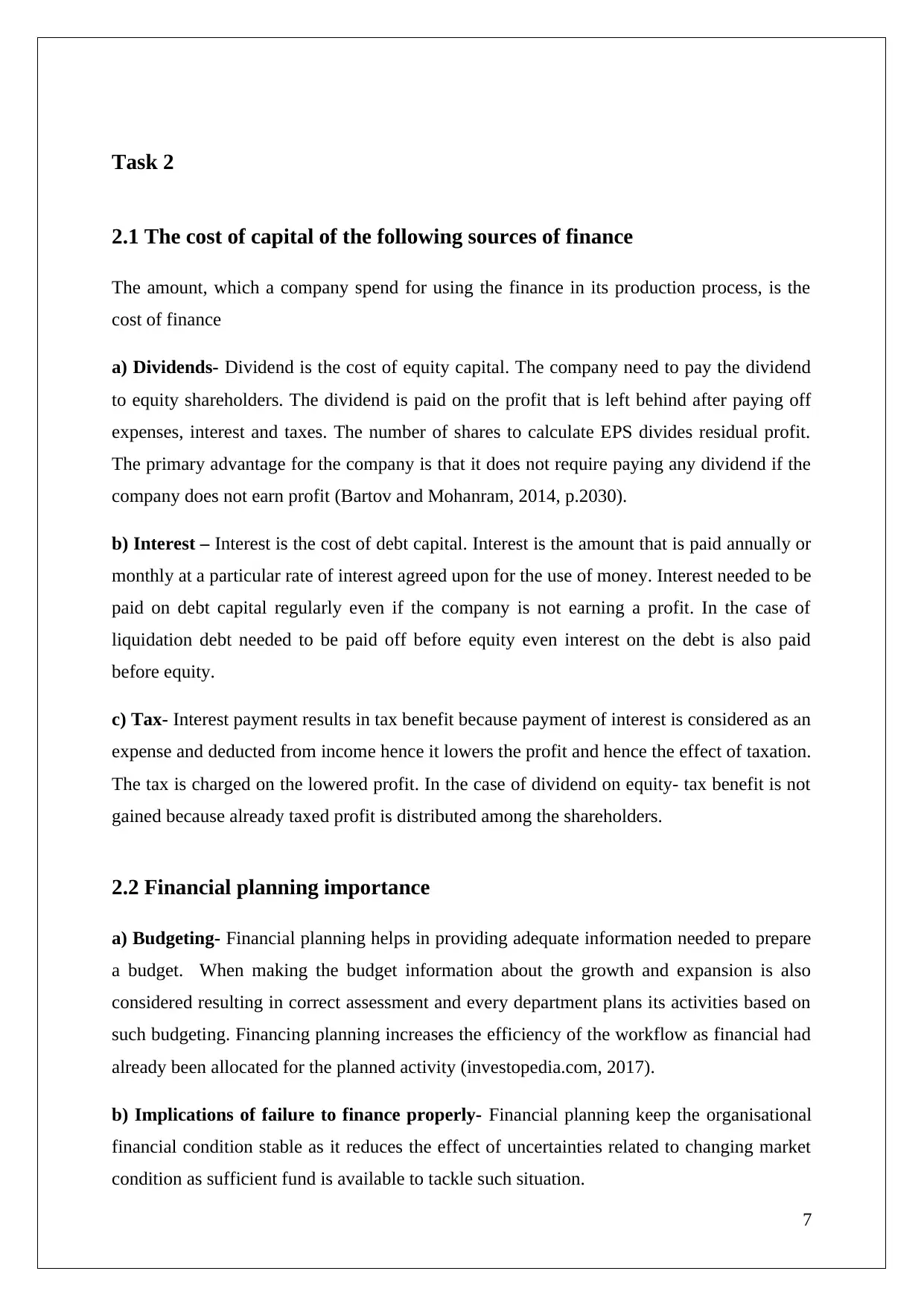
Task 2
2.1 The cost of capital of the following sources of finance
The amount, which a company spend for using the finance in its production process, is the
cost of finance
a) Dividends- Dividend is the cost of equity capital. The company need to pay the dividend
to equity shareholders. The dividend is paid on the profit that is left behind after paying off
expenses, interest and taxes. The number of shares to calculate EPS divides residual profit.
The primary advantage for the company is that it does not require paying any dividend if the
company does not earn profit (Bartov and Mohanram, 2014, p.2030).
b) Interest – Interest is the cost of debt capital. Interest is the amount that is paid annually or
monthly at a particular rate of interest agreed upon for the use of money. Interest needed to be
paid on debt capital regularly even if the company is not earning a profit. In the case of
liquidation debt needed to be paid off before equity even interest on the debt is also paid
before equity.
c) Tax- Interest payment results in tax benefit because payment of interest is considered as an
expense and deducted from income hence it lowers the profit and hence the effect of taxation.
The tax is charged on the lowered profit. In the case of dividend on equity- tax benefit is not
gained because already taxed profit is distributed among the shareholders.
2.2 Financial planning importance
a) Budgeting- Financial planning helps in providing adequate information needed to prepare
a budget. When making the budget information about the growth and expansion is also
considered resulting in correct assessment and every department plans its activities based on
such budgeting. Financing planning increases the efficiency of the workflow as financial had
already been allocated for the planned activity (investopedia.com, 2017).
b) Implications of failure to finance properly- Financial planning keep the organisational
financial condition stable as it reduces the effect of uncertainties related to changing market
condition as sufficient fund is available to tackle such situation.
7
2.1 The cost of capital of the following sources of finance
The amount, which a company spend for using the finance in its production process, is the
cost of finance
a) Dividends- Dividend is the cost of equity capital. The company need to pay the dividend
to equity shareholders. The dividend is paid on the profit that is left behind after paying off
expenses, interest and taxes. The number of shares to calculate EPS divides residual profit.
The primary advantage for the company is that it does not require paying any dividend if the
company does not earn profit (Bartov and Mohanram, 2014, p.2030).
b) Interest – Interest is the cost of debt capital. Interest is the amount that is paid annually or
monthly at a particular rate of interest agreed upon for the use of money. Interest needed to be
paid on debt capital regularly even if the company is not earning a profit. In the case of
liquidation debt needed to be paid off before equity even interest on the debt is also paid
before equity.
c) Tax- Interest payment results in tax benefit because payment of interest is considered as an
expense and deducted from income hence it lowers the profit and hence the effect of taxation.
The tax is charged on the lowered profit. In the case of dividend on equity- tax benefit is not
gained because already taxed profit is distributed among the shareholders.
2.2 Financial planning importance
a) Budgeting- Financial planning helps in providing adequate information needed to prepare
a budget. When making the budget information about the growth and expansion is also
considered resulting in correct assessment and every department plans its activities based on
such budgeting. Financing planning increases the efficiency of the workflow as financial had
already been allocated for the planned activity (investopedia.com, 2017).
b) Implications of failure to finance properly- Financial planning keep the organisational
financial condition stable as it reduces the effect of uncertainties related to changing market
condition as sufficient fund is available to tackle such situation.
7
Paraphrase This Document
Need a fresh take? Get an instant paraphrase of this document with our AI Paraphraser
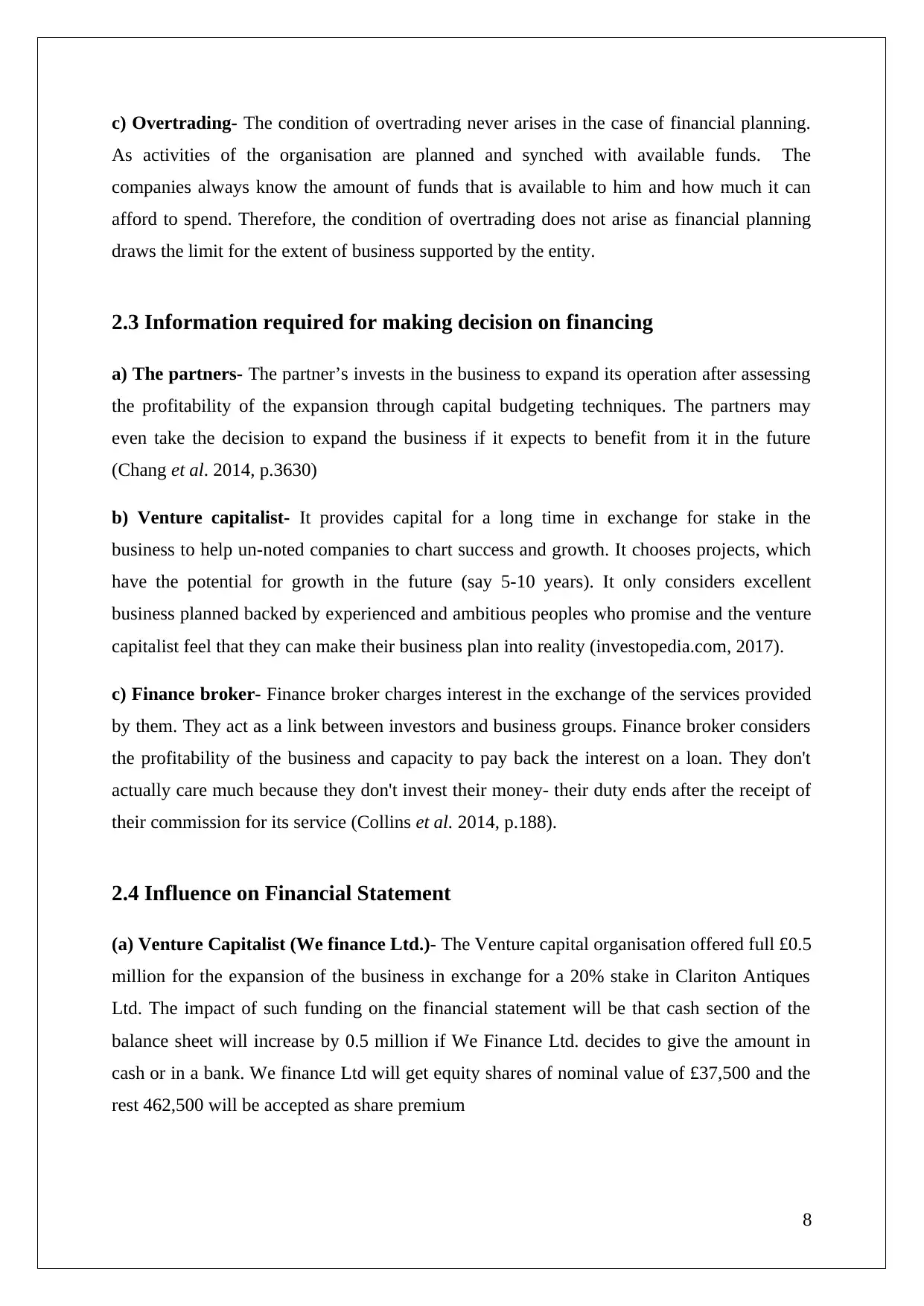
c) Overtrading- The condition of overtrading never arises in the case of financial planning.
As activities of the organisation are planned and synched with available funds. The
companies always know the amount of funds that is available to him and how much it can
afford to spend. Therefore, the condition of overtrading does not arise as financial planning
draws the limit for the extent of business supported by the entity.
2.3 Information required for making decision on financing
a) The partners- The partner’s invests in the business to expand its operation after assessing
the profitability of the expansion through capital budgeting techniques. The partners may
even take the decision to expand the business if it expects to benefit from it in the future
(Chang et al. 2014, p.3630)
b) Venture capitalist- It provides capital for a long time in exchange for stake in the
business to help un-noted companies to chart success and growth. It chooses projects, which
have the potential for growth in the future (say 5-10 years). It only considers excellent
business planned backed by experienced and ambitious peoples who promise and the venture
capitalist feel that they can make their business plan into reality (investopedia.com, 2017).
c) Finance broker- Finance broker charges interest in the exchange of the services provided
by them. They act as a link between investors and business groups. Finance broker considers
the profitability of the business and capacity to pay back the interest on a loan. They don't
actually care much because they don't invest their money- their duty ends after the receipt of
their commission for its service (Collins et al. 2014, p.188).
2.4 Influence on Financial Statement
(a) Venture Capitalist (We finance Ltd.)- The Venture capital organisation offered full £0.5
million for the expansion of the business in exchange for a 20% stake in Clariton Antiques
Ltd. The impact of such funding on the financial statement will be that cash section of the
balance sheet will increase by 0.5 million if We Finance Ltd. decides to give the amount in
cash or in a bank. We finance Ltd will get equity shares of nominal value of £37,500 and the
rest 462,500 will be accepted as share premium
8
As activities of the organisation are planned and synched with available funds. The
companies always know the amount of funds that is available to him and how much it can
afford to spend. Therefore, the condition of overtrading does not arise as financial planning
draws the limit for the extent of business supported by the entity.
2.3 Information required for making decision on financing
a) The partners- The partner’s invests in the business to expand its operation after assessing
the profitability of the expansion through capital budgeting techniques. The partners may
even take the decision to expand the business if it expects to benefit from it in the future
(Chang et al. 2014, p.3630)
b) Venture capitalist- It provides capital for a long time in exchange for stake in the
business to help un-noted companies to chart success and growth. It chooses projects, which
have the potential for growth in the future (say 5-10 years). It only considers excellent
business planned backed by experienced and ambitious peoples who promise and the venture
capitalist feel that they can make their business plan into reality (investopedia.com, 2017).
c) Finance broker- Finance broker charges interest in the exchange of the services provided
by them. They act as a link between investors and business groups. Finance broker considers
the profitability of the business and capacity to pay back the interest on a loan. They don't
actually care much because they don't invest their money- their duty ends after the receipt of
their commission for its service (Collins et al. 2014, p.188).
2.4 Influence on Financial Statement
(a) Venture Capitalist (We finance Ltd.)- The Venture capital organisation offered full £0.5
million for the expansion of the business in exchange for a 20% stake in Clariton Antiques
Ltd. The impact of such funding on the financial statement will be that cash section of the
balance sheet will increase by 0.5 million if We Finance Ltd. decides to give the amount in
cash or in a bank. We finance Ltd will get equity shares of nominal value of £37,500 and the
rest 462,500 will be accepted as share premium
8
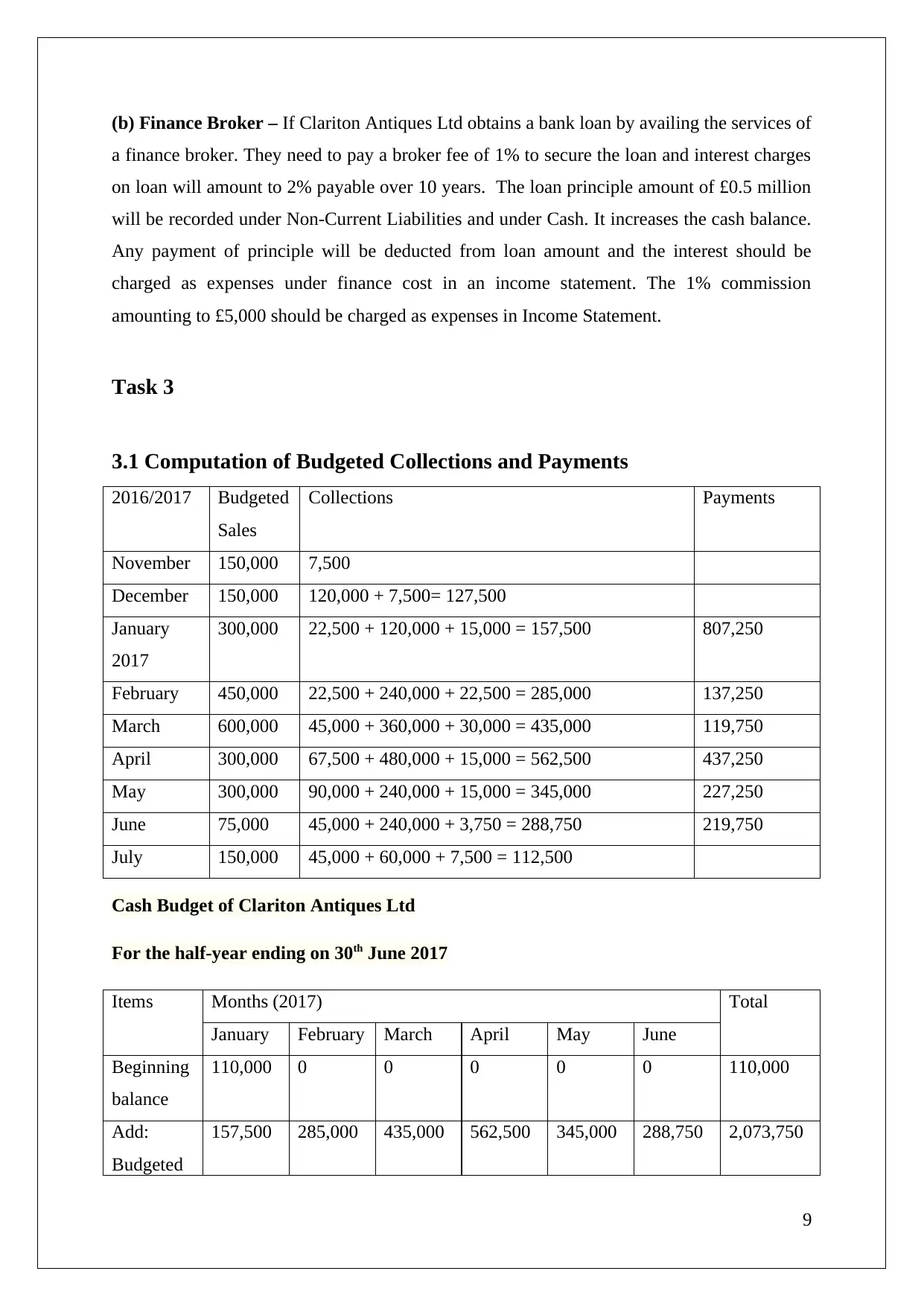
(b) Finance Broker – If Clariton Antiques Ltd obtains a bank loan by availing the services of
a finance broker. They need to pay a broker fee of 1% to secure the loan and interest charges
on loan will amount to 2% payable over 10 years. The loan principle amount of £0.5 million
will be recorded under Non-Current Liabilities and under Cash. It increases the cash balance.
Any payment of principle will be deducted from loan amount and the interest should be
charged as expenses under finance cost in an income statement. The 1% commission
amounting to £5,000 should be charged as expenses in Income Statement.
Task 3
3.1 Computation of Budgeted Collections and Payments
2016/2017 Budgeted
Sales
Collections Payments
November 150,000 7,500
December 150,000 120,000 + 7,500= 127,500
January
2017
300,000 22,500 + 120,000 + 15,000 = 157,500 807,250
February 450,000 22,500 + 240,000 + 22,500 = 285,000 137,250
March 600,000 45,000 + 360,000 + 30,000 = 435,000 119,750
April 300,000 67,500 + 480,000 + 15,000 = 562,500 437,250
May 300,000 90,000 + 240,000 + 15,000 = 345,000 227,250
June 75,000 45,000 + 240,000 + 3,750 = 288,750 219,750
July 150,000 45,000 + 60,000 + 7,500 = 112,500
Cash Budget of Clariton Antiques Ltd
For the half-year ending on 30th June 2017
Items Months (2017) Total
January February March April May June
Beginning
balance
110,000 0 0 0 0 0 110,000
Add:
Budgeted
157,500 285,000 435,000 562,500 345,000 288,750 2,073,750
9
a finance broker. They need to pay a broker fee of 1% to secure the loan and interest charges
on loan will amount to 2% payable over 10 years. The loan principle amount of £0.5 million
will be recorded under Non-Current Liabilities and under Cash. It increases the cash balance.
Any payment of principle will be deducted from loan amount and the interest should be
charged as expenses under finance cost in an income statement. The 1% commission
amounting to £5,000 should be charged as expenses in Income Statement.
Task 3
3.1 Computation of Budgeted Collections and Payments
2016/2017 Budgeted
Sales
Collections Payments
November 150,000 7,500
December 150,000 120,000 + 7,500= 127,500
January
2017
300,000 22,500 + 120,000 + 15,000 = 157,500 807,250
February 450,000 22,500 + 240,000 + 22,500 = 285,000 137,250
March 600,000 45,000 + 360,000 + 30,000 = 435,000 119,750
April 300,000 67,500 + 480,000 + 15,000 = 562,500 437,250
May 300,000 90,000 + 240,000 + 15,000 = 345,000 227,250
June 75,000 45,000 + 240,000 + 3,750 = 288,750 219,750
July 150,000 45,000 + 60,000 + 7,500 = 112,500
Cash Budget of Clariton Antiques Ltd
For the half-year ending on 30th June 2017
Items Months (2017) Total
January February March April May June
Beginning
balance
110,000 0 0 0 0 0 110,000
Add:
Budgeted
157,500 285,000 435,000 562,500 345,000 288,750 2,073,750
9
⊘ This is a preview!⊘
Do you want full access?
Subscribe today to unlock all pages.

Trusted by 1+ million students worldwide
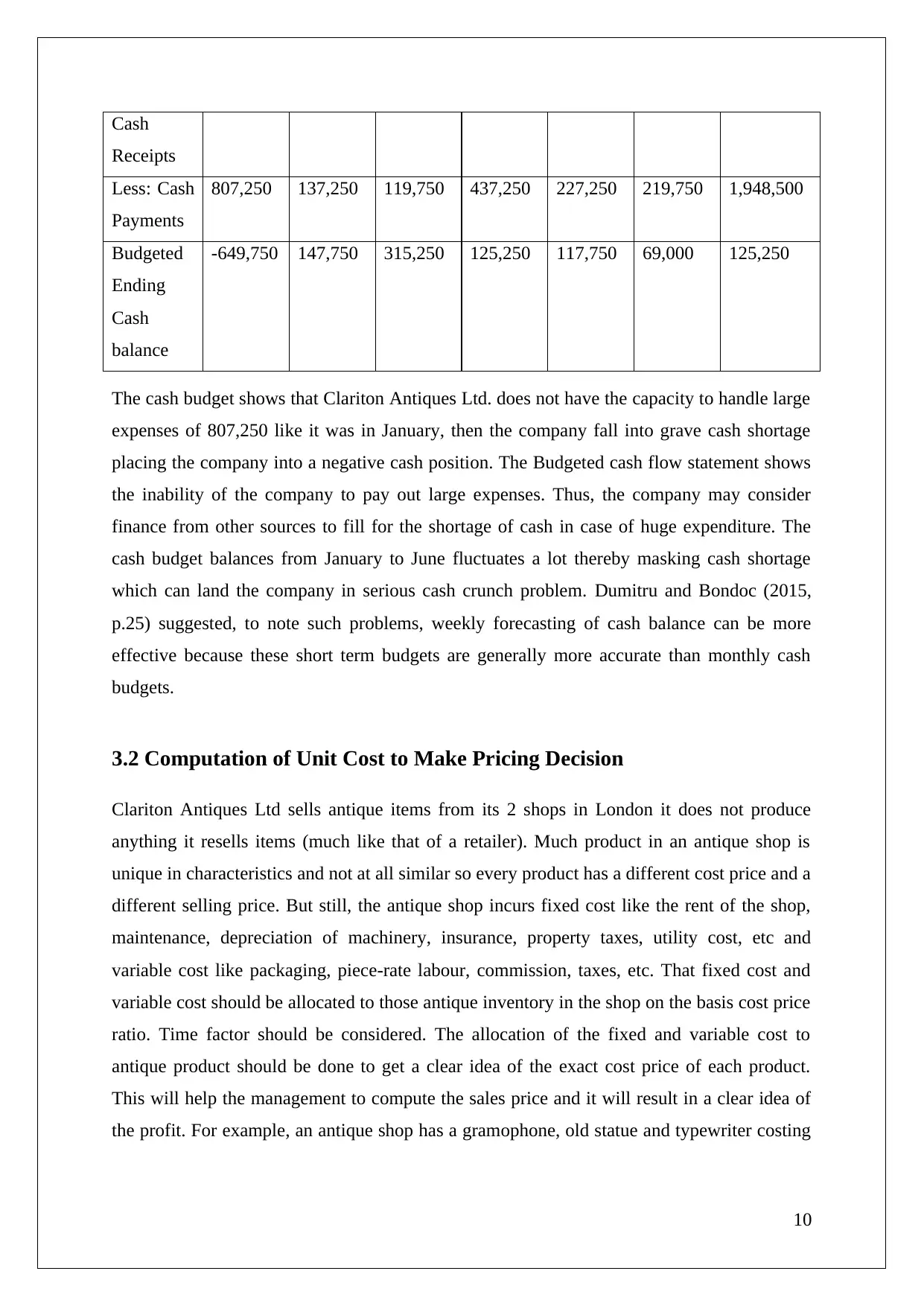
Cash
Receipts
Less: Cash
Payments
807,250 137,250 119,750 437,250 227,250 219,750 1,948,500
Budgeted
Ending
Cash
balance
-649,750 147,750 315,250 125,250 117,750 69,000 125,250
The cash budget shows that Clariton Antiques Ltd. does not have the capacity to handle large
expenses of 807,250 like it was in January, then the company fall into grave cash shortage
placing the company into a negative cash position. The Budgeted cash flow statement shows
the inability of the company to pay out large expenses. Thus, the company may consider
finance from other sources to fill for the shortage of cash in case of huge expenditure. The
cash budget balances from January to June fluctuates a lot thereby masking cash shortage
which can land the company in serious cash crunch problem. Dumitru and Bondoc (2015,
p.25) suggested, to note such problems, weekly forecasting of cash balance can be more
effective because these short term budgets are generally more accurate than monthly cash
budgets.
3.2 Computation of Unit Cost to Make Pricing Decision
Clariton Antiques Ltd sells antique items from its 2 shops in London it does not produce
anything it resells items (much like that of a retailer). Much product in an antique shop is
unique in characteristics and not at all similar so every product has a different cost price and a
different selling price. But still, the antique shop incurs fixed cost like the rent of the shop,
maintenance, depreciation of machinery, insurance, property taxes, utility cost, etc and
variable cost like packaging, piece-rate labour, commission, taxes, etc. That fixed cost and
variable cost should be allocated to those antique inventory in the shop on the basis cost price
ratio. Time factor should be considered. The allocation of the fixed and variable cost to
antique product should be done to get a clear idea of the exact cost price of each product.
This will help the management to compute the sales price and it will result in a clear idea of
the profit. For example, an antique shop has a gramophone, old statue and typewriter costing
10
Receipts
Less: Cash
Payments
807,250 137,250 119,750 437,250 227,250 219,750 1,948,500
Budgeted
Ending
Cash
balance
-649,750 147,750 315,250 125,250 117,750 69,000 125,250
The cash budget shows that Clariton Antiques Ltd. does not have the capacity to handle large
expenses of 807,250 like it was in January, then the company fall into grave cash shortage
placing the company into a negative cash position. The Budgeted cash flow statement shows
the inability of the company to pay out large expenses. Thus, the company may consider
finance from other sources to fill for the shortage of cash in case of huge expenditure. The
cash budget balances from January to June fluctuates a lot thereby masking cash shortage
which can land the company in serious cash crunch problem. Dumitru and Bondoc (2015,
p.25) suggested, to note such problems, weekly forecasting of cash balance can be more
effective because these short term budgets are generally more accurate than monthly cash
budgets.
3.2 Computation of Unit Cost to Make Pricing Decision
Clariton Antiques Ltd sells antique items from its 2 shops in London it does not produce
anything it resells items (much like that of a retailer). Much product in an antique shop is
unique in characteristics and not at all similar so every product has a different cost price and a
different selling price. But still, the antique shop incurs fixed cost like the rent of the shop,
maintenance, depreciation of machinery, insurance, property taxes, utility cost, etc and
variable cost like packaging, piece-rate labour, commission, taxes, etc. That fixed cost and
variable cost should be allocated to those antique inventory in the shop on the basis cost price
ratio. Time factor should be considered. The allocation of the fixed and variable cost to
antique product should be done to get a clear idea of the exact cost price of each product.
This will help the management to compute the sales price and it will result in a clear idea of
the profit. For example, an antique shop has a gramophone, old statue and typewriter costing
10
Paraphrase This Document
Need a fresh take? Get an instant paraphrase of this document with our AI Paraphraser

£1,000, £5,000 and £4,000 and the shop has a fixed cost of £5,000 and variable cost of
£15,000
A B C D E F G
Product Cost
Price(£)
Fixed Cost(£) Variable
cost(£)
Total Cost
Price
A+B+C
Profit
Margin
20%
Sales
Price
E×
120%
Gramophone 1,000 1000
10,000 ×5,000=500
1,000
10,000 ×15,000=1,500
3,000 20% 3,600
Old Statue 5,000 5000
10,000 ×5,000=2,500
5,000
10,000 ×15,000=7,500
15,000 20% 18,000
Old
Typewriter
4,000 4,000
10,000 × 4000=2,000
4,000
10,000 ×15,000=6,000
12,000 20% 14,400
Total 10,000 5,000 15,000 30,000 20% 36,000
The fixed cost and the variable cost are distributed among the products in the ratio of the cost
price. Then the total cost price consists of the acquisition price, fixed cost and variable cost.
Even profit margins of 20% profit on cost price have been assumed to calculate the sales
price. Such allocation of fixed and variable cost to the cost price of the product helps in sales
price calculation. Exact calculation of profit of every product is possible and it relieves the
management of much stress on profit computation, opines Smith et al. (2015).
3.3 Capital Expenditure Decision
Net
Present
Value
of £1
@14%
Investment
1 (£m)
Sum
(£m)
Investment
2 (£m)
Sum
(£m)
NPV of
Investment
1(£m)
NPV of
Investment
2(£m)
Initial
Cost
1 8.6 8.6 4.4 4.4 8.6 4.4
Cash
Inflows
Year 1 0.877 1.6 1.6 0.8 0.8 1.4032 0.7016
Year 2 0.769 2.8 4.4 1.4 2.2 2.1532 1.0766
11
£15,000
A B C D E F G
Product Cost
Price(£)
Fixed Cost(£) Variable
cost(£)
Total Cost
Price
A+B+C
Profit
Margin
20%
Sales
Price
E×
120%
Gramophone 1,000 1000
10,000 ×5,000=500
1,000
10,000 ×15,000=1,500
3,000 20% 3,600
Old Statue 5,000 5000
10,000 ×5,000=2,500
5,000
10,000 ×15,000=7,500
15,000 20% 18,000
Old
Typewriter
4,000 4,000
10,000 × 4000=2,000
4,000
10,000 ×15,000=6,000
12,000 20% 14,400
Total 10,000 5,000 15,000 30,000 20% 36,000
The fixed cost and the variable cost are distributed among the products in the ratio of the cost
price. Then the total cost price consists of the acquisition price, fixed cost and variable cost.
Even profit margins of 20% profit on cost price have been assumed to calculate the sales
price. Such allocation of fixed and variable cost to the cost price of the product helps in sales
price calculation. Exact calculation of profit of every product is possible and it relieves the
management of much stress on profit computation, opines Smith et al. (2015).
3.3 Capital Expenditure Decision
Net
Present
Value
of £1
@14%
Investment
1 (£m)
Sum
(£m)
Investment
2 (£m)
Sum
(£m)
NPV of
Investment
1(£m)
NPV of
Investment
2(£m)
Initial
Cost
1 8.6 8.6 4.4 4.4 8.6 4.4
Cash
Inflows
Year 1 0.877 1.6 1.6 0.8 0.8 1.4032 0.7016
Year 2 0.769 2.8 4.4 1.4 2.2 2.1532 1.0766
11

Year 3 0.674 3.4 7.8 2.0 4.2 2.2916 1.348
Year 4 0.592 3.6 11.4 2.4 6.6 2.1312 1.4208
Year 5 0.519 4.0 15.4 2.3 8.9 2.076 1.1937
Year 6 0.455 4.2 19.6 2.6 11.5 1.911 1.183
Total 19.6 11.5 11.9662 6.9237
Payback Period- According to Wang (2014, p.960), it gives the period in years and months
required to recover the initial investments made in the project at the starting. It does not
consider the time value of money. Payback method can be used to compare between projects
(investopedia.com, 2017).
Investment 1 earns back a total of £7.8 million at the end of year 3 against the initial cost of
£8.6 million. It requires earning £0.8 million more for the complete withdrawal of the initial
cost of the project. In year 4 it earns £3.6 million out of which the period needed to recover
£0.8 million needs to be calculated over a period of 12 months. For this, it is assumed that
there is constant cash flow and no fluctuation in business conditions (Dung, 2016, p.490).
. = 0.8
3.6 ×12= 2.667 months
Therefore 2.667 months is required to recover the remaining 0.8 million. Therefore, the total
time taken to recover the initial cost of investment 1 is 3 years and 2.667 months.
Investment 2 earns back a total of £4.2 million at the end of year 3 against the initial cost of
£4.4 million. It requires earning 0.2 million more for the complete withdrawal of the initial
cost of the project. In year 4 it earns £2.4 million out of which the period needed to recover
£0.2 million needs to be calculated over a period of 12 months. For this, it is assumed that
there are constant cash flow and no fluctuation in business conditions.
0.2
2.4 × 12= 1 month
Therefore 1 month is required to recover the remaining 0.2 million. So the total time taken to
recover the initial cost is 3 years 1 month.
12
Year 4 0.592 3.6 11.4 2.4 6.6 2.1312 1.4208
Year 5 0.519 4.0 15.4 2.3 8.9 2.076 1.1937
Year 6 0.455 4.2 19.6 2.6 11.5 1.911 1.183
Total 19.6 11.5 11.9662 6.9237
Payback Period- According to Wang (2014, p.960), it gives the period in years and months
required to recover the initial investments made in the project at the starting. It does not
consider the time value of money. Payback method can be used to compare between projects
(investopedia.com, 2017).
Investment 1 earns back a total of £7.8 million at the end of year 3 against the initial cost of
£8.6 million. It requires earning £0.8 million more for the complete withdrawal of the initial
cost of the project. In year 4 it earns £3.6 million out of which the period needed to recover
£0.8 million needs to be calculated over a period of 12 months. For this, it is assumed that
there is constant cash flow and no fluctuation in business conditions (Dung, 2016, p.490).
. = 0.8
3.6 ×12= 2.667 months
Therefore 2.667 months is required to recover the remaining 0.8 million. Therefore, the total
time taken to recover the initial cost of investment 1 is 3 years and 2.667 months.
Investment 2 earns back a total of £4.2 million at the end of year 3 against the initial cost of
£4.4 million. It requires earning 0.2 million more for the complete withdrawal of the initial
cost of the project. In year 4 it earns £2.4 million out of which the period needed to recover
£0.2 million needs to be calculated over a period of 12 months. For this, it is assumed that
there are constant cash flow and no fluctuation in business conditions.
0.2
2.4 × 12= 1 month
Therefore 1 month is required to recover the remaining 0.2 million. So the total time taken to
recover the initial cost is 3 years 1 month.
12
⊘ This is a preview!⊘
Do you want full access?
Subscribe today to unlock all pages.

Trusted by 1+ million students worldwide
1 out of 20
Related Documents
Your All-in-One AI-Powered Toolkit for Academic Success.
+13062052269
info@desklib.com
Available 24*7 on WhatsApp / Email
![[object Object]](/_next/static/media/star-bottom.7253800d.svg)
Unlock your academic potential
Copyright © 2020–2025 A2Z Services. All Rights Reserved. Developed and managed by ZUCOL.





